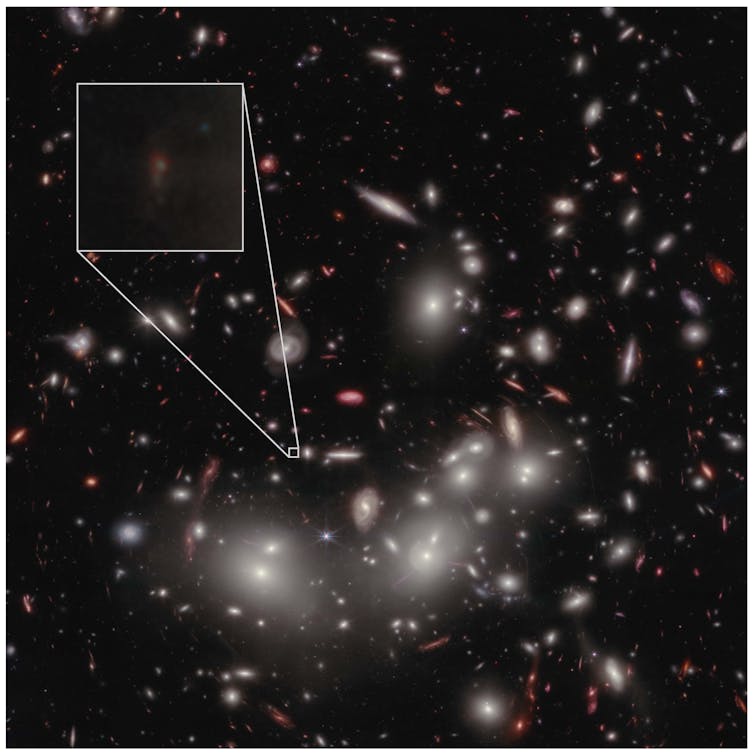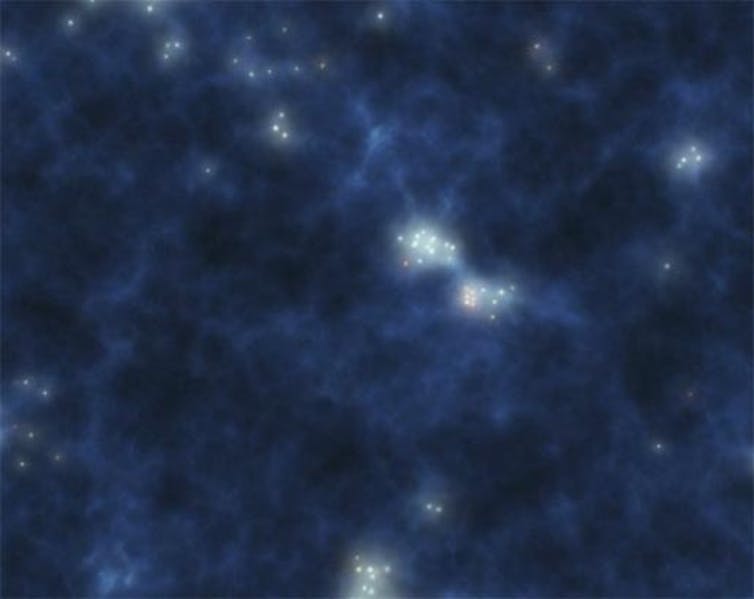The universe we live in is a transparent one, where light from stars and galaxies shines bright against a clear, dark backdrop. But this wasn’t always the case – in its early years, the universe was filled with a fog of hydrogen atoms that obscured light from the earliest stars and galaxies.
NASA/JPL-Caltech, CC BY
The intense ultraviolet light from the first generations of stars and galaxies is thought to have burned through the hydrogen fog, transforming the universe into what we see today. While previous generations of telescopes lacked the ability to study those early cosmic objects, astronomers are now using the James Webb Space Telescope’s superior technology to study the stars and galaxies that formed in the immediate aftermath of the Big Bang.
I’m an astronomer who studies the farthest galaxies in the universe using the world’s foremost ground- and space-based telescopes. Using new observations from the Webb telescope and a phenomenon called gravitational lensing, my team confirmed the existence of the faintest galaxy currently known in the early universe. The galaxy, called JD1, is seen as it was when the universe was only 480 million years old, or 4% of its present age.
A brief history of the early universe
The first billion years of the universe’s life were a crucial period in its evolution. In the first moments after the Big Bang, matter and light were bound to each other in a hot, dense “soup” of fundamental particles.
However, a fraction of a second after the Big Bang, the universe expanded extremely rapidly. This expansion eventually allowed the universe to cool enough for light and matter to separate out of their “soup” and – some 380,000 years later – form hydrogen atoms. The hydrogen atoms appeared as an intergalactic fog, and with no light from stars and galaxies, the universe was dark. This period is known as the cosmic dark ages.
The arrival of the first generations of stars and galaxies several hundred million years after the Big Bang bathed the universe in extremely hot UV light, which burned – or ionized – the hydrogen fog. This process yielded the transparent, complex and beautiful universe we see today.
Astronomers like me call the first billion years of the universe – when this hydrogen fog was burning away – the epoch of reionization. To fully understand this time period, we study when the first stars and galaxies formed, what their main properties were and whether they were able to produce enough UV light to burn through all the hydrogen.
The search for faint galaxies in the early universe
The first step toward understanding the epoch of reionization is finding and confirming the distances to galaxies that astronomers think might be responsible for this process. Since light travels at a finite speed, it takes time to arrive to our telescopes, so astronomers see objects as they were in the past.
For example, light from the center of our galaxy, the Milky Way, takes about 27,000 years to reach us on Earth, so we see it as it was 27,000 years in the past. That means that if we want to see back to the very first instants after the Big Bang (the universe is 13.8 billion years old), we have to look for objects at extreme distances.
Because galaxies residing in this time period are so far away, they appear extremely faint and small to our telescopes and emit most of their light in the infrared. This means astronomers need powerful infrared telescopes like Webb to find them. Prior to Webb, virtually all of the distant galaxies found by astronomers were exceptionally bright and large, simply because our telescopes weren’t sensitive enough to see the fainter, smaller galaxies.
However, it’s the latter population that are far more numerous, representative and likely to be the main drivers to the reionization process, not the bright ones. So, these faint galaxies are the ones astronomers need to study in greater detail. It’s like trying to understand the evolution of humans by studying entire populations rather than a few very tall people. By allowing us to see faint galaxies, Webb is opening a new window into studying the early universe.
A typical early galaxy
JD1 is one such “typical” faint galaxy. It was discovered in 2014 with the Hubble Space Telescope as a suspect distant galaxy. But Hubble didn’t have the capabilities or sensitivity to confirm its distance – it could make only an educated guess.
Small and faint nearby galaxies can sometimes be mistaken as distant ones, so astronomers need to be sure of their distances before we can make claims about their properties. Distant galaxies therefore remain “candidates” until they are confirmed. The Webb telescope finally has the capabilities to confirm these, and JD1 was one of the first major confirmations by Webb of an extremely distant galaxy candidate found by Hubble. This confirmation ranks it as the faintest galaxy yet seen in the early universe.
To confirm JD1, an international team of astronomers and I used Webb’s near-infrared spectrograph, NIRSpec, to obtain an infrared spectrum of the galaxy. The spectrum allowed us to pinpoint the distance from Earth and determine its age, the number of young stars it formed and the amount of dust and heavy elements that it produced.

Guido Roberts-Borsani/UCLA; original images: NASA, ESA, CSA, Swinburne University of Technology, University of Pittsburgh, STScI
Gravitational lensing, nature’s magnifying glass
Even for Webb, JD1 would be impossible to see without a helping hand from nature. JD1 is located behind a large cluster of nearby galaxies, called Abell 2744, whose combined gravitational strength bends and amplifies the light from JD1. This effect, known as gravitational lensing, makes JD1 appear larger and 13 times brighter than it ordinarily would.
Without gravitational lensing, astronomers would not have seen JD1, even with Webb. The combination of JD1’s gravitational magnification and new images from another one of Webb’s near-infrared instruments, NIRCam, made it possible for our team to study the galaxy’s structure in unprecedented detail and resolution.
Not only does this mean we as astronomers can study the inner regions of early galaxies, it also means we can start determining whether such early galaxies were small, compact and isolated sources, or if they were merging and interacting with nearby galaxies. By studying these galaxies, we are tracing back to the building blocks that shaped the universe and gave rise to our cosmic home.



